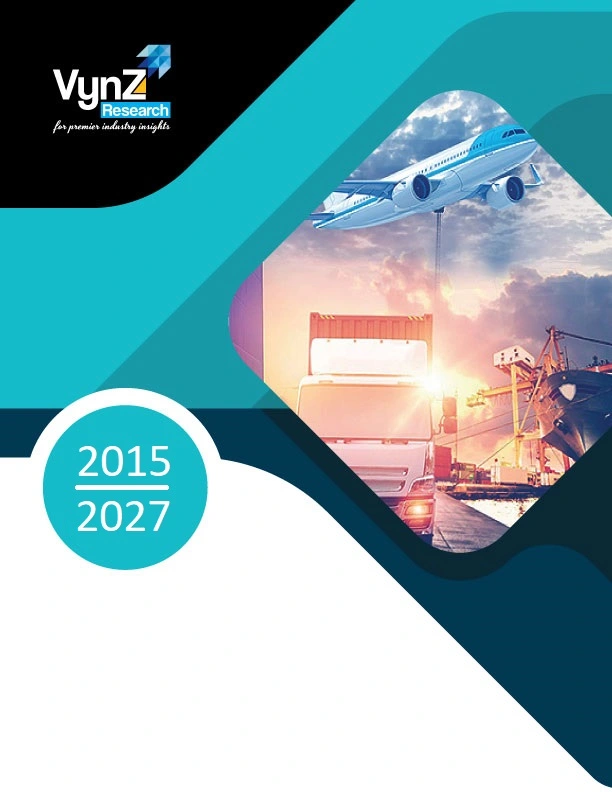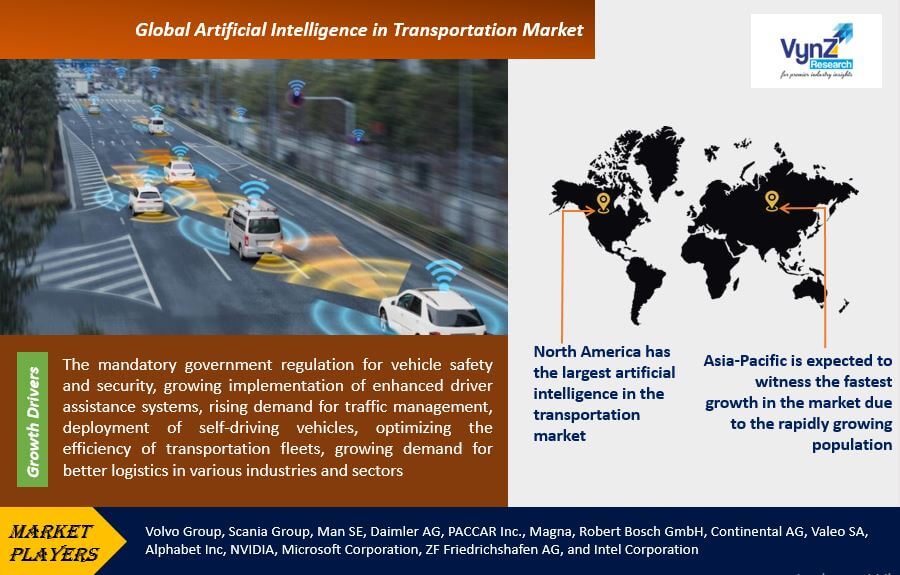| Status : Published | Published On : Dec, 2023 | Report Code : VRAT4008 | Industry : Automotive & Transportation | Available Format :

|
Page : 238 |

Global Artificial Intelligence in Transportation Market – Analysis and Forecast (2025-2030)
Industry Insights by Machine Learning Technology (Computer Vision, Deep Learning, Context Awareness, and Natural Language Processing), by Process (Data Mining, Signal Recognition, and Image Recognition), by Application (Autonomous Trucks, Semi-Autonomous Trucks, and HMI in Truck), by IoT Communication (LTE, LPWAN, and 5G), and by Offering (Hardware, and Software)
Industry Overview
The Global Artificial Intelligence in the transportation market is anticipated to grow from USD 1.47 billion in 2023 to USD 11.35 billion by 2030, growing at a CAGR of 19.5% during the forecast period 2025-2030. Artificial intelligence is the most sought-after technology globally, driving the growth of AI in the transportation market. Artificial intelligence is a computer-operated task that involves human intelligence for decision-making. The global artificial intelligence in the transportation market is growing at a substantial rate due to the rising government regulation for vehicle safety and security and the growing implementation of enhanced driver assistance systems. Moreover, the advancement of autonomous vehicles integrated with smart features, reducing the operating cost of transportation, and rising demand for traffic management solutions are the driving factors for the growth of AI in the transportation market. Different processes contribute to artificial intelligence in transportation market size. The market has witnessed a high demand for data mining during the forecast period due to the rising demand for prognostic maintenance in the transportation industry.

The COVID-19 outbreak has affected many industries globally due to disruption in the supply chain and the temporary closure of manufacturing operations across the world. There is a need to prioritize the safety of people and public transport operators are reorganizing their operation procedures and regain the safety and confidence of travellers by proper sanitation, and social distancing norms. AI, IoT, and intelligent transportation system (ITS) applications help in solving various transportation problems.
Artificial Intelligence in Transportation Market Segmentation
Insight by Machine Learning Technology
Based on machine learning technology, artificial intelligence in the transportation market is divided into computer vision, deep learning, context awareness, and natural language processing. Among all machine learning technologies, the deep learning segment dominates the market and is projected to witness a faster pace in the market, as it is extensively used in the advancement of autonomous vehicles, which demand to see, drive, think, and learn. Rapid advancement in data generation and computing technologies such as GPU has increased the prominence of deep learning which has the competence to resolve huge volumes of raw data, searching for insight from complex systems and making them powerful.
Insight by Process
Based on the process, artificial intelligence in the transportation market is segmented into data mining, signal recognition, and image recognition. Among all the processes, the data mining segment is anticipated to grow at the fastest rate during the forecast period owing to the rising requirement for prognostic maintenance in the transportation industry, the growing impact of artificial intelligence in car safety and infotainment, and requiring additional data of images and signals to be managed and analyzed. In addition, the signal recognition segment dominates the market in 2020, due to its adoption in intelligent transportation systems, signals in the form of text, gestures, mapping, tracking, etc. are progressively used in many safety applications.
Insight by Application
Based on application, the AI in the transportation market is categorized into autonomous trucks, semi-autonomous trucks, truck platooning, precision mapping, predictive maintenance, HMI in the trucks, and others. Of all the applications, autonomous trucks are anticipated to grow at the fastest rate and account for the largest share in artificial intelligence in the transportation market as autonomous vehicles have huge potential to prevent road accidents and help in saving lives. Moreover, controlling the speed of autonomous vehicles provides proper management and a smooth flow of traffic.
Insight by Offering
Based on the offering, AI in the transportation market is bifurcated into hardware and software. The hardware is subdivided into a Central Processing Unit (CPU), Graphics Processing Unit (GPU), sensors, and others. The software segment is further sub-segmented into platforms and solutions. Among all the offerings, the software accounted for the largest share of artificial intelligence in the transportation market due to machine translation, object recognition, and demand for progression in the areas of object perception. Moreover, the rising adoption of software as a service platforms such as Microsoft Azure in human-machine interface (HMI) applications.
Insight by IoT Communication
Based on IoT communication, artificial intelligence in the transportation market is subdivided into LTE, LPWAN, and 5G. The 5G segment is anticipated to have a high CAGR during the forecast period as it delivers high transmission speed, low latency rate, increased reliability & availability, and ubiquitous network user experience.
Global Artificial Intelligence in Transportation Market Report Coverage
|
Report Metric |
Details |
|
Historical Period |
2018 - 2023 |
|
Base Year Considered |
2024 |
|
Forecast Period |
2025 - 2030 |
|
Market Size in 2024 |
U.S.D. 1.47 Billion |
|
Revenue Forecast in 2030 |
U.S.D. 11.35 Billion |
|
Growth Rate |
19.5% |
|
Segments Covered in the Report |
By Machine Learning Technology,By Process,By Application,By Offering,By IoT Communication |
|
Report Scope |
Market Trends, Drivers, and Restraints; Revenue Estimation and Forecast; Segmentation Analysis; Impact of COVID-19; Companies’ Strategic Developments; Market Share Analysis of Key Players; Company Profiling |
|
Regions Covered in the Report |
North America,Europe,Asia-Pacific (APAC),Rest of the World (RoW) |
Industry Dynamics
Artificial Intelligence in Transportation Market Growth Drivers
The mandatory government regulation for vehicle safety and security, growing implementation of enhanced driver assistance systems, rising demand for traffic management, deployment of self-driving vehicles, optimizing the efficiency of transportation fleets, growing demand for better logistics in various industries and sectors, and increasing emphasis towards decreasing the operational and transportation costs are the primary growth drivers for artificial intelligence in the transportation market.
Development of autonomous vehicles by the implementation of safety features such as adaptive cruise control (ACC), advanced driver assistance system (ADAS), collision warning, and lane-keep assist will reduce the risk of alcohol or drug-impaired drivers, thus facilitating the growth of the artificial intelligence in the transportation market. For instance, several companies are capitalizing on the improvement of self-driving trucks.
In addition, truck platooning is the emerging segment for the growth of artificial intelligence in the transportation market. For instance, artificial intelligence technologies such as forward collision warning, sensor fusion, signal recognition, and lane-keep assist are the major factors driving the growth of truck platooning. Moreover, mounting environmental concerns, strict government regulations for emissions, mounting fuel efficiency, and concerns about traffic congestion have enhanced the growth of truck platooning in the market.
Artificial Intelligence in Transportation Market Challenges
The high cost of artificial intelligence systems because cloud-based that require expensive bandwidth, superior training, and skills, time-to-time maintenance, and replacement are the major challenges for the growth of artificial intelligence in the transportation market. In addition, infrastructure development costs, machine learning is data-driven, cybersecurity, and data privacy are also hampering the growth of AI in the transportation market.
Artificial Intelligence in Transportation Market Opportunities
The rapid development of AI in the transportation market in the form of drone taxis, and automated train operations (ATO) in the railway sector are creating promising opportunities in the market.
Artificial Intelligence in Transportation Market Geographic Overview
Geographically, North America has the largest artificial intelligence in the transportation market due to the rising integration of self-driving vehicles and the increase in government funding. Moreover, the region is home to major technology companies, a lack of truck drivers, rising investment in autonomous trucks, and government regulations for compliance, safety, and accountability (CSA) are also facilitating the growth of the North American market.
In addition, Asia-Pacific is expected to witness the fastest growth in the market due to the rapidly growing population and increase in the sale of self-driving vehicles. In addition, robust economic growth, the shift of the unorganized third-party logistics sector to the organized sector, and the growing logistics and supply chain sector are also driving the growth of the Asia-Pacific artificial intelligence in the transportation market.
Artificial Intelligence in Transportation Market Competitive Insight
Key players operating in artificial intelligence in the transportation market are catering to the demand by collaborating, acquiring small players, and investing in R&D activities across the globe.
Scania launched Propart. Autonomous vehicles and advanced driver assistance systems with robust and precise positioning enable reliable operations.
ZF launched Middleware for series vehicles, which will be available from 2024. The company’s growth is closely connected to the development of application software for mobility domains such as automated driving, integrated safety, vehicle motion control, and electric mobility.
Volvo Group, Scania Group, Man SE, Daimler AG, PACCAR Inc., Magna, Robert Bosch GmbH, Continental AG, Valeo SA, Alphabet Inc, NVIDIA, Microsoft Corporation, ZF Friedrichshafen AG, and Intel Corporation are the key players offering artificial intelligence in transportation.
The Artificial Intelligence in Transportation Market report offers a comprehensive market segmentation analysis along with an estimation for the forecast period 2025–2030.
Segments Covered in the Report
- By Machine Learning Technology
- Computer Vision
- Deep Learning
- Context Awareness
- Natural Language Processing (NLP)
- By Process
- Data Mining
- Signal Recognition
- Image Recognition
- By Application
- Autonomous Trucks
- Semi-Autonomous Trucks
- Truck Platooning
- Precision Mapping
- Predictive Maintenance
- HMI in the Trucks
- Others
- By Offering
- Hardware
- Central Processing Unit (CPU)
- Graphics Processing Unit (GPU)
- Sensors
- Others
- Software
- Platforms
- Solutions
- Hardware
- By IoT Communication
- LTE
- LPWAN
- 5G
Region Covered in the Report
- North America
- U.S.
- Canada
- Mexico
- Europe
- Germany
- U.K.
- France
- Italy
- Spain
- Russia
- Rest of Europe
- Asia-Pacific (APAC)
- China
- Japan
- India
- South Korea
- Rest of Asia-Pacific
- Rest of the World (RoW)
- Brazil
- Saudi Arabia
- South Africa
- U.A.E.
- Other Countries
.png)
Source: VynZ Research
.png)
Source: VynZ Research
Frequently Asked Questions
Purchase Options
Latest Report
Research Methodology
- Desk Research / Pilot Interviews
- Build Market Size Model
- Research and Analysis
- Final Deliverabvle
Connect With Our Sales Team
- Toll-Free: 1 888 253 3960
- Phone: +91 9960 288 381
- Email: enquiry@vynzresearch.com
Artificial Intelligence in Transportation Market
